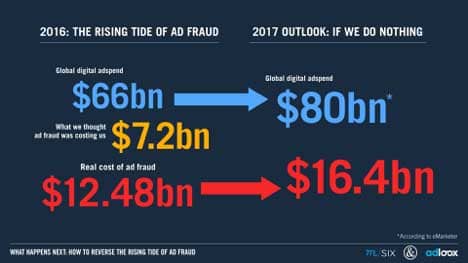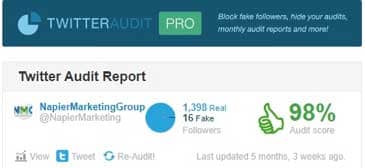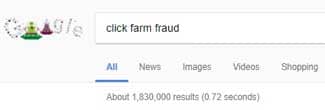Buyer Beware – Your Digital Marketing Campaigns Are Likely To Be Full Of Fraud By Click Farms And Bots.
Furniture World News Desk on
8/29/2017
By Bill Napier
Part 1 of 2 in the series. First, we’re going to discuss the fraud, in the second series we’ll discuss how to prevent it
Recently I wrote about my thoughts and research about how people do not like your digital ads –
ALL THE HYPE ABOUT ONLY USING DIGITAL FOR YOUR RETAIL STORES MARKETING-I'M NOT BUYING IT – Yep over 75% of people think they’re intrusive and more. Now add this to the mix. Maybe those that are supposedly liking/following/clicking on your ads may be fraudulent.
For close to two years I’ve been inundated with the next best digital marketing platform that we could utilize to help our retailer and brand clients get the most out of utilizing the web to show more, tell more and most of all sell more.
Remember the adage from John Wanamaker – “
Half the money I spend on advertising is wasted; the trouble is I don't know which half”. Well this may be truer today than back in the turn of the century when he stated it.
I’ve sat through dozens of presentations and I must be honest, I don’t understand a lot of what they are presenting and I’m a pretty smart guy. I explain to these people that if I don’t understand it, how will my clients understand it.
After all this time, I think I found a platform I can get behind, more on that later. First, I need to address the elephant in the room. AD FRAUD.
With all these companies out there promoting the next best FAD MARKETING gimmick, I asked myself the question: What is the ROI reality of these so called digital ad driven companies? I always hear the words/statements “
We Increased Conversions by XXX%”. People,
conversions are clicks and these are riddled with potential AD FRAUD and here is why and how it’s done and you don’t know it’s happening.
According to
Business Insider, a study commissioned by WPP, clicks automatically generated by bots, could reach $16.4 billion in 2017 and could reach over $50BN in 2025. Hey, this fraud and the profits are
second only to organized crime’s drug trade!

But that’s not all. Look at this:
Adloox conducted its study across 200 billion daily bid requests, 4 billion ad calls, and 10 billion ad impressions a month, over a period of 12 months.
Across the 200 billion bid requests, 50% were detected as being either non-human traffic (either a bot or a hijacked device) or fraudulent traffic, which includes bad actors trying to spoof real web domains to attempt to pass off to ad buyers as premium publishers. John Wanamaker would be proud!
Here's the worst part. AD FRAUD IS NOT ILLEGAL
One of the biggest reasons fraud is so rampant is simply that it’s not illegal. Unlike credit card fraud, bank fraud, false advertising, etc., nobody is going to jail for ad fraud, and it’s not exactly the sort of activity that elicits a crackdown from law enforcement, which means there is significantly less risk involved. And yet it’s extremely lucrative.

So what are the two main culprits in this massive fraud.
#1 – CLICK FARMS
Click Farms are usually located in developing countries with very low wage rates, such as the Philippines, India, and Bangladesh, among others. Many use proxy servers or VPN. Workers are paid low amounts, perhaps one dollar for a thousand Facebook Likes. Most probably earn about $300 to $400 a year.
The Click Farms then sell their likes and followers at a much higher price.
You can check this yourself.
Just Google the words “Buy Facebook likes” and you’ll find several companies listing prices. They include Buy Cheap Social at $16 for 1,000 ‘real human likes’; BoostLikes at $71 per 1,000 likes; or iBuyFans with 1,000 likes for $17.99 or 10,000 for $149.99.
There are ways to check the validity of your followers. One such option is available for Twitter called
Twitter Audit. I used it on my
@NapierMarketing Twitter account and I’m happy to say that 98% of my followers are all real. One thing, however, I have 1,557 followers, more than the 1,398 followers they claim).

BUT who are the 16 followers that are fake? I check every request “to follow”, LinkedIn, etc. I review profiles, everything before I accept and it looks like I got duped by 16 people which reaffirms my statement BUYER BEWARE!
When people follow me, I’m astounded when I see they have 100M followers, etc. Hmmmmmm I ask myself.
There is even an advertisement that’s in your face called
www.clickmonkeys.com. When researching this article, they came up #1 organically in Google’s search.
Their claim to fame and marketing message is to solicit marketers who are under pressure to have their social platforms perform. If you hire them, you’ll get the clicks/followers, etc. to boost your rankings, creating a perception that you “are liked/loved”.

Their statement on how they work states:
Would we be offering this service over the Internet if it weren’t legal? Hell no! Click Monkeys!!™ is a Ukrainian company and the giant tanker ship click farm we have stationed just outside U.S. waters off the coast of San Francisco is registered at a Ukrainian berth so we’re not subject to any U.S. laws!

Over 20,000 Click Monkeys!!™ live and work aboard our click farm. They work in shifts of 5,000 24 hours aday, 7 daysa week, 365 days a year!! Each monkey is able to access 12 pages per minute which gives us incredible traffic potential, just look at this math:
1 monkey x 1 hour = 720-page views/clicks
1 monkey x 1 day = 17,280-page views/clicks
5,000 monkeys x 1 day 86,400,000 page views/clicks!!!!
If you Google the phrase Click Farm Fraud you’ll get:

I think that makes my point.
#2 BOTS
In a recent article in
ADWEEK it was written “Online ad fraud driven by bots will cost brands $7.2 billion globally this year, according to a forecast in a new joint study by the
Association of National Advertisers and
White Ops. That's up from the $6.3 billion the two organizations predicted in a
similar report for 2015.
What is a BOT. According to
ZVELO
“Ad fraud happens when a bot attempts to imitate legitimate web traffic (acting like a real person visiting a website) and generate additional (but fraudulent) web page views (and therefore revenue) for the website publisher. The advertisers’ budgets are compromised, as their dollars are being wasted on ads being served to bots rather than humans. This results in the advertisers and the end users paying the price for this fraud, as well as being exposed to the risks associated with malicious and fraudulent bots. Recent estimates have put the cost of Ad fraud at 20-30% or more of the online advertising spending, or several billion dollars a quarter.
Some tactics deployed by Ad-fraud bots are:
- Retargeting Fraud: This bot can mimic a human’s intentions, such as an interest in a specific brand of car. Ads targeted to a particular niche result in a higher CPM than untargeted ads. These bots deceive advertisers into believing they are receiving valuable, targeted traffic and clicks.
- Sophisticated Fraud: This type of bot travels around the web to visit websites, view ads and clicks using sophisticated algorithms. Think of it as a digital ghost that is always boosting the click-through numbers.
- Ad-fraud Botnets: These bots run quietly in the background of infected computers without making their presence known to the owner. Then, under the hacker’s remote control, the botnet — which can be rented through black-market Internet forums — is directed to visit certain websites. The most sophisticated bots are programmed to click from one website to another, watch videos for their duration, and even add items to an online shopping basket”.
Advertising Age had a headline;
Report: For Every $3 Spent on Digital Ads, Fraud Takes $1
WOW, 30% is contributed to fraud, John Wanamaker may like this because it’s less than his 50%, but are you willing to accept these numbers? I’m not.
So what should you do?
First, focus on real people. Email campaigns and digital marketing companies that focus on a users IP address that can marry that information to a real home address and prove it. There are companies out there like El-Toro. I’ve been talking to them for a year, and their case studies in the furniture industry have me convinced they have a better mousetrap. Why? Because they hate “click marketing” and their case studies show successes in sales dollars vs. spend, instead of the ubiquitous Clicks/Conversions vs. sales dollars spent. You can find out more of how this works on my website: www.napiermkt.com
Second, make sure that whoever is running your digital campaigns “prove to you” that the traffic generated is real.
If you Google Digital Ad Auditing, you’ll find 3,600,000 results

If your digital ad company doesn’t give you a full audit, RUN. If they audit shows a percentage of potential BOT/Click Farm Fraud, make sure you get a credit back for that percentage.
In summary, I hate FAD MARKETING. FAD MARKETING is where a marketing person pushes out information on the newest/coolest FAD without providing Due Diligence. They talk their retailers into a platform to spend or waste their money on the newest supposed best way to attract and engage customers. They report ambiguous statistics, use generalities in their results and only provide one side of the equation.
That hurts our retailers, makes them suspicious of new or traditional programs that do work, which in turn hurts their profitability and speeds up their demise.
BUYER BEWARE
Information shared from
ZVELO.COM was posted with permission
More about the Author: Bill Napier is Managing Partner of Napier Marketing Group. He has been the chief marketing officer of several small, medium and large companies throughout his career, most notably Ashley Furniture Industries Inc. Bill is also a featured writer and speaker in the retail industry. His passion is to help retail brands & brick mortar retailers grow their businesses by creating, guiding and deploying successful marketing B2B/B2C solutions integrating traditional marketing with the web/social media. He has demonstrated this with his FREE website www.social4retail.com with hundreds of articles and “how To” strategies for retailers and brands. Bill can be reached at; billnapier@napiermkt.com or 612-217-1297.